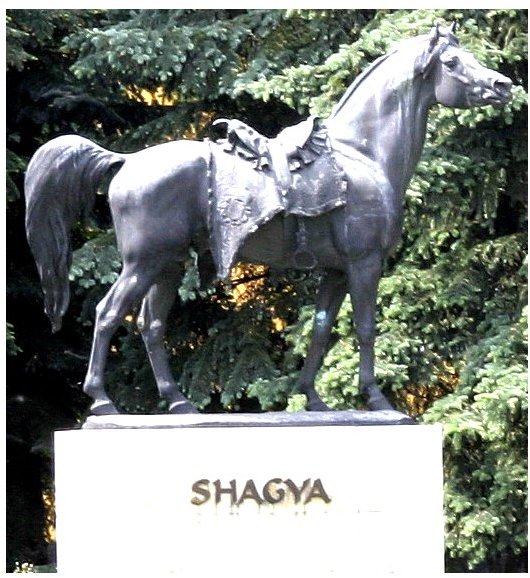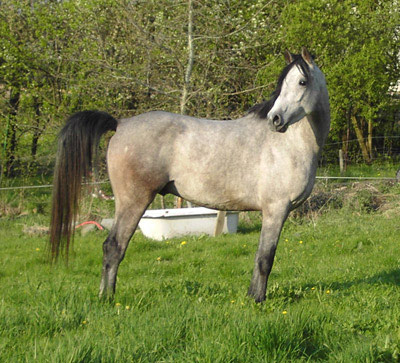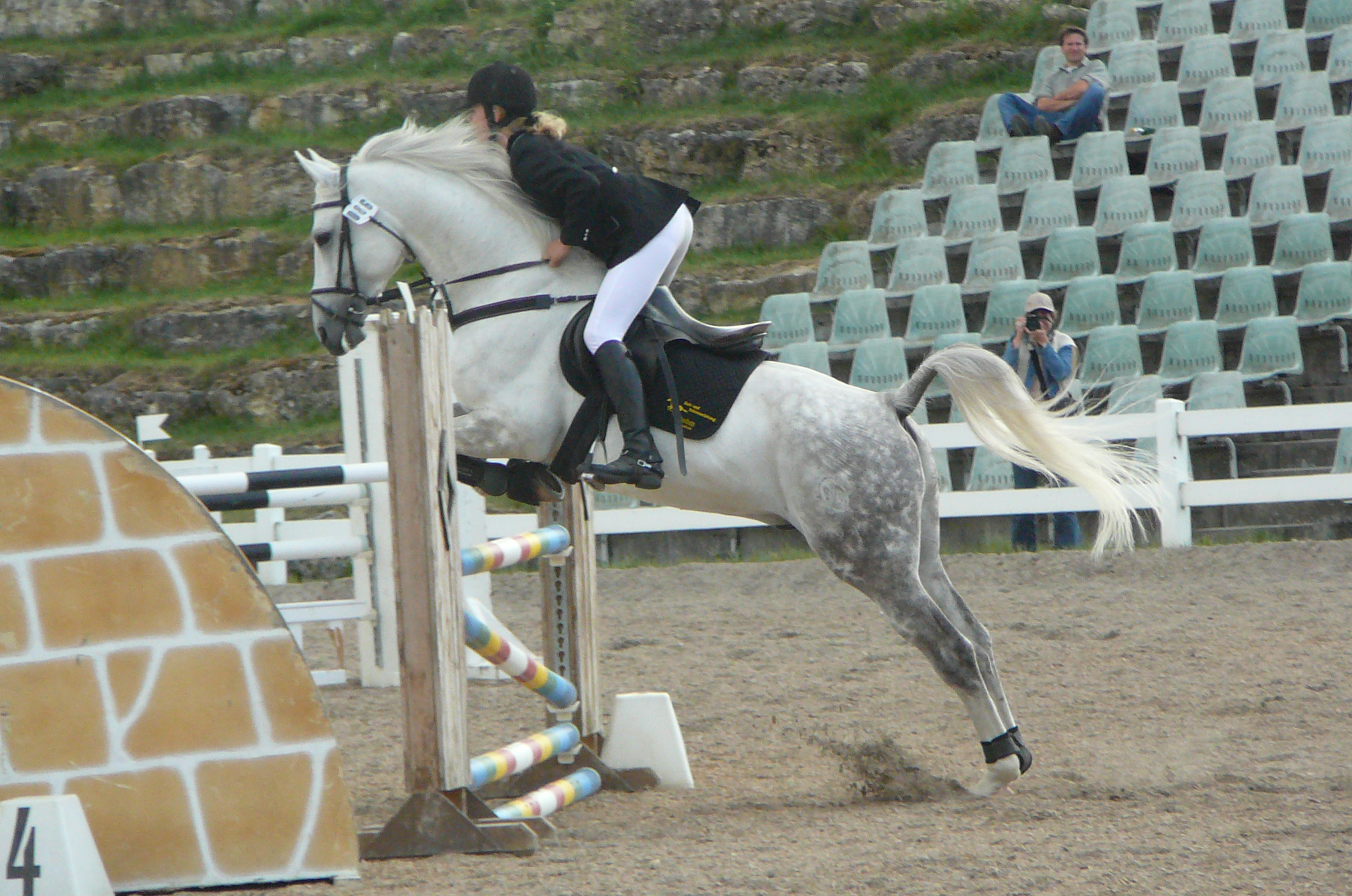Shagya Arabian on:
[Wikipedia]
[Google]
[Amazon]
The Shagya Arabian is a horse breed which was developed in the
 One of the major founding sires was Shagya, a
One of the major founding sires was Shagya, a
scanned article a
/ref> (or, some say part-Arabian) Stallion (horse), stallion with some ancestors of the Kehilan and Siglavy strains. Born in
 While Shagyas are not considered "pure" or
While Shagyas are not considered "pure" or 


"Le Shagya, champion du monde!"
. ''CEER de France Comte''. Referenced May 21, 2008.
Austro-Hungarian Empire
Austria-Hungary, often referred to as the Austro-Hungarian Empire,, the Dual Monarchy, or Austria, was a constitutional monarchy and great power in Central Europe between 1867 and 1918. It was formed with the Austro-Hungarian Compromise of ...
during the 19th century at the Bábolna
Bábolna is a town in Komárom-Esztergom county, Hungary.
Bábolna houses the famous riding schoolPettko-Szandtner Tibor Lovas Szakiskola es Kollegiumand a world-famous stud farm
A stud farm or stud in animal husbandry is an establishment fo ...
, Mezőhegyes
Mezőhegyes is a town in Békés county, in the Southern Great Plain region of south-east Hungary. It is home to the Hungarian State Stud ( hu, italic=no, Mezőhegyesi Állami Ménes), founded in 1784 and famous for its Nonius, Furioso-North Sta ...
, Radautz, Piber
The Piber Federal Stud (''Bundesgestüt Piber'') is a stud farm dedicated to the breeding of Lipizzan horses, located at the village of Piber, near the town of Köflach in western Styria, Austria. It was founded in 1798, began breeding Lipizza ...
, and Topolcianky studs. Today it is most often seen in the Czech Republic
The Czech Republic, or simply Czechia, is a landlocked country in Central Europe. Historically known as Bohemia, it is bordered by Austria to the south, Germany to the west, Poland to the northeast, and Slovakia to the southeast. The ...
, Austria
Austria, , bar, Östareich officially the Republic of Austria, is a country in the southern part of Central Europe, lying in the Eastern Alps. It is a federation of nine states, one of which is the capital, Vienna, the most populous ...
, Romania
Romania ( ; ro, România ) is a country located at the crossroads of Central Europe, Central, Eastern Europe, Eastern, and Southeast Europe, Southeastern Europe. It borders Bulgaria to the south, Ukraine to the north, Hungary to the west, S ...
, the former Yugoslavia
Yugoslavia (; sh-Latn-Cyrl, separator=" / ", Jugoslavija, Југославија ; sl, Jugoslavija ; mk, Југославија ;; rup, Iugoslavia; hu, Jugoszlávia; rue, label=Pannonian Rusyn, Югославия, translit=Juhoslavija ...
n countries, Poland
Poland, officially the Republic of Poland, is a country in Central Europe. It is divided into 16 administrative provinces called voivodeships, covering an area of . Poland has a population of over 38 million and is the fifth-most populous ...
, Germany
Germany,, officially the Federal Republic of Germany, is a country in Central Europe. It is the second most populous country in Europe after Russia, and the most populous member state of the European Union. Germany is situated betwe ...
, and Hungary
Hungary ( hu, Magyarország ) is a landlocked country in Central Europe. Spanning of the Carpathian Basin, it is bordered by Slovakia to the north, Ukraine to the northeast, Romania to the east and southeast, Serbia to the south, Croatia a ...
, but has been exported to other nations and is bred around the world. A purebred
Purebreds are "cultivated varieties" of an animal species achieved through the process of selective breeding. When the lineage of a purebred animal is recorded, that animal is said to be "pedigreed". Purebreds breed true-to-type which means the p ...
Shagya Arabian today has bloodlines that can be traced in all lines to the stud books of Rădăuți
Rădăuți (; german: Radautz; hu, Radóc; pl, Radowce; uk, Радівці, ''Radivtsi''; yi, ראַדעװיץ ''Radevits''; tr, Radoviçe) is a town in Suceava County, north-eastern Romania. It is situated in the historical region of Bukovi ...
, Babolna, and Topolcianky. The breed is considered by some to be a subtype of Arabian horse
The Arabian or Arab horse ( ar, الحصان العربي , DIN 31635, DMG ''ḥiṣān ʿarabī'') is a horse breed, breed of horse that originated on the Arabian Peninsula. With a distinctive head shape and high tail carriage, the Arabian is ...
, but due to the presence of a small amount of non-Arabian breeding others consider it to be an Anglo-Arabian
The Anglo-Arabian or Anglo-Arab is a crossbred, part-Arabian horse that now also has its own status as a horse breed. It is the result of a Thoroughbred (hence, the prefix "Anglo") being crossed with an Arabian. The cross can be made betw ...
or a partbred Arabian.
Origin
 One of the major founding sires was Shagya, a
One of the major founding sires was Shagya, a gray
Grey (more common in British English) or gray (more common in American English) is an intermediate color between black and white. It is a neutral or achromatic color, meaning literally that it is "without color", because it can be composed o ...
Arabian
The Arabian Peninsula, (; ar, شِبْهُ الْجَزِيرَةِ الْعَرَبِيَّة, , "Arabian Peninsula" or , , "Island of the Arabs") or Arabia, is a peninsula of Western Asia, situated northeast of Africa on the Arabian Plate. ...
"The Other Arabian Horse" ''Arabian Horse World,'' April, 1983.scanned article a
/ref> (or, some say part-Arabian) Stallion (horse), stallion with some ancestors of the Kehilan and Siglavy strains. Born in
Syria
Syria ( ar, سُورِيَا or سُورِيَة, translit=Sūriyā), officially the Syrian Arab Republic ( ar, الجمهورية العربية السورية, al-Jumhūrīyah al-ʻArabīyah as-Sūrīyah), is a Western Asian country loc ...
in 1810, he was taller than the average Arabian of the time, standing at the withers
The withers is the ridge between the shoulder blades of an animal, typically a quadruped. In many species, it is the tallest point of the body. In horses and dogs, it is the standard place to measure the animal's height. In contrast, cattle ar ...
. His weigh is 530 kg.
He was mostly used for crossbreeding
A crossbreed is an organism with purebred parents of two different breeds, varieties, or populations. ''Crossbreeding'', sometimes called "designer crossbreeding", is the process of breeding such an organism, While crossbreeding is used to main ...
at Babolna, bred few pure-blooded or ''asil'' Arabian mares, and thus has no pure Arabian descendants today.http://www.shagya-araber.info/shagya-line.htm "Pure Bred Shagya-Araber Society International" Many of the Arabian stallions standing at Babolna and other studs were crossbred
A crossbreed is an organism with purebred parents of two different breeds, varieties, or populations. ''Crossbreeding'', sometimes called "designer crossbreeding", is the process of breeding such an organism, While crossbreeding is used to main ...
with mares who already possessed a great deal of Arabian influence due to the long Turkish occupation of Eastern Europe. Some Thoroughbred
The Thoroughbred is a horse breed best known for its use in horse racing. Although the word ''thoroughbred'' is sometimes used to refer to any breed of purebred horse, it technically refers only to the Thoroughbred breed. Thoroughbreds are c ...
s and Lipizzan
The Lipizzan or Lipizzaner ( hr, Lipicanac, cz, Lipicán, hu, Lipicai, it, Lipizzano, sr, Lipicaner, sl, Lipicanec), is a European breed of riding horse developed in the Habsburg Empire in the sixteenth century. It is of Baroque type, and i ...
s were also used. In all cases, meticulous pedigree
Pedigree may refer to:
Breeding
* Pedigree chart, a document to record ancestry, used by genealogists in study of human family lines, and in selective breeding of other animals
** Pedigree, a human genealogy (ancestry chart)
** Pedigree (animal ...
records were kept.
Originally, these predominantly, but not asil
Asil may refer to:
*Asil (name)
* American Society of International Law (ASIL)
* Asil, Arabian horses who have pedigrees that can be traced to identifiable desert-bred horses from the Middle East
* Asil chicken, a breed of chicken
* Asil Kara, a s ...
Arabian horses were referred to by the generic
Generic or generics may refer to:
In business
* Generic term, a common name used for a range or class of similar things not protected by trademark
* Generic brand, a brand for a product that does not have an associated brand or trademark, other ...
term ''Araberrasse'' (Arab "race" or breed, indicating predominantly Arabian ancestry) but this was changed after the second World War to Shagya by hippologist Dr. Gramazky because he was worried the non-purebred descendants of Shagya would be mixed up with the purebred Arabian horses that were also produced in Hungary. At the time, this name was chosen since Shagya was in virtually every pedigree as an ancestor, though many other Arabian bloodlines are also a part of the Shagya breed.
Bloodlines
 While Shagyas are not considered "pure" or
While Shagyas are not considered "pure" or asil
Asil may refer to:
*Asil (name)
* American Society of International Law (ASIL)
* Asil, Arabian horses who have pedigrees that can be traced to identifiable desert-bred horses from the Middle East
* Asil chicken, a breed of chicken
* Asil Kara, a s ...
Arabians, they have a closed stud book
A breed registry, also known as a herdbook, studbook or register, in animal husbandry and the hobby of animal fancy, is an official list of animals within a specific breed whose parents are known. Animals are usually registered by their breeders ...
and have special status within the World Arabian Horse Organization The World Arabian Horse Organization (WAHO) is the world organization for the preservation, improvement and preservation of Arabian horses. WAHO grants membership to nations after examination of national breeding stud book
A breed registry, als ...
(WAHO). In 1978, WAHO stated that Shagya Arabians that have been bred pure after the system of Babolna and Topolcianky may be termed "purebred Shagya Arabians", and the Shagya breeders' organisation is under WAHO patronage as associate members, allowed to use the WAHO emblem. However, WAHO also was clear that "purebred" in this case means that the horses have been bred pure among themselves and are not to be confused with the term "purebred Arabian". Some aficionados note that the meticulous recordkeeping of the Hungarian studs actually has produced horses with longer and more complete pedigrees than some horses accepted as purebred Arabians by mainstream registries. However, despite this argument, Shagyas remain a distinct bloodline group and are generally not accepted as pure-blooded Arabians.

Traits
The Shagya Arabian exhibits traits similar to theasil
Asil may refer to:
*Asil (name)
* American Society of International Law (ASIL)
* Asil, Arabian horses who have pedigrees that can be traced to identifiable desert-bred horses from the Middle East
* Asil chicken, a breed of chicken
* Asil Kara, a s ...
or purebred Arabian horse, with high carried tail, sound bone and excellent endurance. However, due to the small influx of non-Arabian breeding and the breeding goals of the Hungarian studs, Shagyas tend to be taller, less refined, and bigger-boned than purebred Arabians; the modern Shagya is usually at least 15 hands
A hand is a prehensile, multi-fingered appendage located at the end of the forearm or forelimb of primates such as humans, chimpanzees, monkeys, and lemurs. A few other vertebrates such as the koala (which has two opposable thumbs on each " ...
tall and commonly 16 hands, whereas the breed standard for the Arabian ranges from 14.1 to 15.1 hands, with some individuals over and under that height.
Uses
This breed is recognized as a riding horse, and is also driven inharness
A harness is a looped restraint or support. Specifically, it may refer to one of the following harness types:
* Bondage harness
* Child harness
* Climbing harness
* Dog harness
* Pet harness
* Five-point harness
* Horse harness
* Parrot harness
* ...
. It was a hardy cavalry
Historically, cavalry (from the French word ''cavalerie'', itself derived from "cheval" meaning "horse") are soldiers or warriors who fight mounted on horseback. Cavalry were the most mobile of the combat arms, operating as light cavalry ...
horse and is now popular in sport horse
A sport horse or sporthorse is a type of horse, rather than any particular breed. The term is usually applied to horses bred for the traditional Olympic equestrian sporting events of dressage, eventing, show jumping, and combined driving, but ...
disciplines such as dressage
Dressage ( or ; a French term, most commonly translated to mean "training") is a form of horse riding performed in exhibition and competition, as well as an art sometimes pursued solely for the sake of mastery. As an equestrian sport defined b ...
, eventing
Eventing (also known as three day eventing or horse trials) is an equestrian event where a single horse and rider combine and compete against other competitors across the three disciplines of dressage, cross-country, and show jumping. Thi ...
and endurance riding
Endurance riding is an equestrian sport based on controlled long-distance races. It is one of the international competitions recognized by the FEI. There are endurance rides worldwide. Endurance rides can be any distance, though they are rare ...
. The 2006 FEI Endurance World Champion was a Shagya gelding bred at Babolna.. ''CEER de France Comte''. Referenced May 21, 2008.
See also
*Arabian horse
The Arabian or Arab horse ( ar, الحصان العربي , DIN 31635, DMG ''ḥiṣān ʿarabī'') is a horse breed, breed of horse that originated on the Arabian Peninsula. With a distinctive head shape and high tail carriage, the Arabian is ...
*Gidran
The Gidran, Gidrán, or Hungarian Anglo-Arab is a horse breed developed in Hungary from bloodstock that included the Arabian horse. All members of the breed are Chestnut. It is an endangered breed today, with only about 200 living repre ...
References
External links
* http://www.performanceshagyaregistry.org - Performance Shagya-Arabian Registry *http://www.Shagyas.com - Shagya breed information portal *http://www.shagya-araber.info/indexe.htm - International Shagya Society *http://www.shagyaregistry.com - American Shagya Arabian Verband *http://www.shagya.net - North American Shagya Arabian Society *https://web.archive.org/web/20080509123714/http://www.horsequest.com/bredshow/shagya/shagya.htm Shagya Horse Breed Spotlight {{Authority control Horse breeds Part-Arabian breeds of horses and ponies